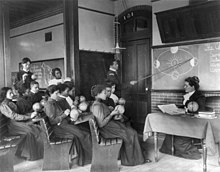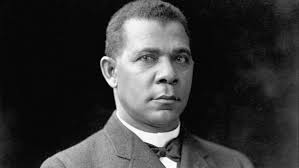History
Hampton University is a private historically black university located in Hampton, Virginia, United States. It was founded in 1868 by black and white leaders of the American Missionary Association after the American Civil War to provide education to freedmen. In 1878 it established a program for teaching Native Americans, which lasted until 1923.
The campus looking south across the harbor of Hampton Roads was founded on the grounds of "Little Scotland", a former plantation in Elizabeth City County not far from Fortress Monroe and the Grand Contraband Camp that gathered nearby. These facilities represented freedom to former slaves, who sought refuge with Union forces during the first year of the war.
The American Missionary Association (AMA) responded in 1861 to the former slaves' need for education by hiring its first mulatto teacher, Mary Smith Peake, who had secretly been teaching slaves and free blacks in the area despite the state's prohibition in law. She first taught for the AMA on September 17, 1861 and was said to gather her pupils under a large oak. After the tree was the site in 1863 of the first reading in the former Confederate states of the Emancipation Proclamation, it was called the Emancipation Oak. The tree, now a symbol of the university and of the city, is part of the National Historic Landmark District at Hampton University.
The Hampton Agricultural and Industrial School, later called the Hampton Institute, was founded in 1868 after the war by the biracial leadership of the AMA, who were chieflyCongregational and Presbyterian ministers. It was first led by former Union General Samuel Chapman Armstrong. Among the school's famous alumni is Dr. Booker T. Washington, an educator who founded the Tuskegee Institute, another college supported by the AMA.
Campus and local information
The campus contains several buildings that contribute to its National Historic Landmark district: Virginia-Cleveland Hall (freshman female dormitory, as well as former home to the school's two cafeterias), Wigwam building (home to administrative offices), Academy Building (administrative offices), Memorial Chapel (religious services) and the President's Mansion House.
The original High School on the campus became Phenix Hall when Hampton City Public Schools opened a new Phoenix High School in 1959. Phoenix Hall was damaged in a minor fire on June 12, 2008.
The Emancipation Oak was cited by the National Geographic Society as one of the 10 great trees in the world.
The waterfront campus is settled near the mouth of the Chesapeake Bay.
A 15-acre portion of the campus along the Hampton River, including many of the older buildings, is a U.S. National Historic Landmark District. Buildings included are:
- Mansion House, original plantation residence of Little Scotland
- Virginia Hall built in 1873
- Academic Hall
- Wigwam
- Marquand Memorial Chapel, a Romanesque Revival red brick chapel with a 150-foot (46 m) tower
In addition, Cleveland Hall, Ogden, and the Administration building are also included in the district.
The district was listed on the National Register of Historic Places in 1969, and declared a National Historic Landmark in 1974
Academics
 - An 1899 class in mathematical geography.
- An 1899 class in mathematical geography.
Hampton University has 11 accredited schools & colleges.
- School of Engineering and Technology
- School of Business
- School of Education and Human Development
- School of Pharmacy
- School of Journalism and Communication
- School of Nursing
- School of Liberal Arts
- School of Science
- University College
- College of Virginia Beach
- Graduate College
As of 2015, Hampton offers 48 baccalaureate programs, 23 master programs, 8 doctoral programs, 2 professional programs, and 8 associate/certificate programs.
Hampton's student to faculty ratio is 10 to 1 which is better than the national university average of 18 to 1.
Hampton University consistently ranks among the top three historically black colleges in the nation.
Notable Alumni
Hampton University’s most notable alumni is Booker T. Washington. After walking 500 miles to Hampton from Malden, WV at age 16, he graduated with the Class of 1875. Upon appointment by Samuel Chapman Armstrong, Washington became the first leader of Tuskegee University in the year 1881.
Other notable alumni include
- Lawyer and Publisher Robert Abbott
- Actor Benjamin Brown
- Editor-in-Chief of Essence Magazine Angela Burt-Murray
- Radio Celebrity Spencer Christian
- Educator and Civil Rights Leader Septima Poinsette Clark
- NBA Basketball Player Jazwyn Cowan
- Renowned Sociologist St. Clair Drake
- Politician Al Eisenberg
- Judge Vanessa Gilmore (youngest appointed federal court judge)
- NBA Basketball Player Devin Green
- Politician Algie Thomas Howell Jr.
- President and Founder of the Gloucester Institute and current member of the NASA Advisory Council Kay Coles James
- Mother of Martin Luther King Jr. Alberta Williams King
- Artist, Educator and founder of the International Review of African American Art Samella Sanders Lewis
- Author, Poet and Playwright M. Carl Holman
- NBA Basketball Player and Coach Rick Mahorn
- Lawyer, Professor and current Principal Deputy Assistant Attorney General for the Office of Legal Policy in the U.S. Department of Justice Spencer Overton
- First African American Mayor of Trenton, NJ Douglas Palmer
- President of Oracle Corp. Charles E. Phillips
- U.S. Ambassador to Nigeria Robin R. Sanders
- Newspaper Publisher John H. Sengstacke
- Emmy Award Winning Comedian Wanda Sykes
- NFL Football Player Cordell Jerome Taylor
- Bishop Ted Thomas, Sr.
- 26th Governor of the Virgin Islands Charles Turnbull
- Former member of the Illinois House of representatives Wyvetter H. Younge.
1. http://www.hamptonu.edu/about/notable_alumni.cfm
2. "Fire damages historic building on HU campus —". Dailypress.com. Retrieved2012-09-29.
3. http://www.hamptonu.edu/global/accreditation.cfm
4. https://en.wikipedia.org/wiki/Hampton_University#History
5. http://www.hamptonu.edu/about/facts.cfm




